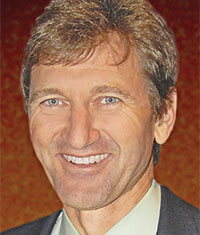The U.S. election for president is upon us. The world is watching; as goes the U.S. economy, so goes the global economy.
The U.S. election for president is upon us. The world is watching; as goes the U.S. economy, so goes the global economy.

Scott W. Tinker
2008-09 AAPG President
It will not always be so, and perhaps soon other major economies will join the United States at the apex of the global economic pyramid. China in many ways is close – not per capita, but nationwide, as a unified and perhaps historically unique blend of government socialism, economic capitalism and common atheism. China is rising.
Russia also is ascending and sits atop more energy (coal, oil, natural gas and alternatives) than any other country in the world. High energy prices have bolstered the economy; Moscow is booming. This recent Russian surge is seen no more clearly than by Europe, who depends on Russia for much of its energy.
However, for now the U.S. economy is still the main economic driver. For evidence look no farther than the recent mortgage crisis cum lending institution collapse cum stock market eruption cum largest tax-funded corporate bailout in history.
I was part of a small AAPG delegation last month visiting several major companies and large universities in Russia, Poland, Germany and the U.K. when U.S. markets plummeted and world markets followed. The world is indeed watching.
But perhaps placing the blame for economic downturn on mortgage and lending institutions misses some of the trees in the forest.
Yes, uninformed borrowers made poor decisions and aggressive (greedy?) lenders were eager to stoke the fires with high-risk loans. Credit liquidity is vital and a large part of the current economic crisis, but equally fundamental is the cost of energy.
The U.S. economy has gone into recession three times since 1970. Each time it was preceded by a steep rise in oil price. The current recession – unfortunately economists may not tell us whether the United States is in a recession until after it has happened (a perfect view of the past!) – is no exception. As discussed here in August, energy costs underpin the economy; perhaps this economic downturn is really no surprise.
The world is watching because it must watch. It has been eight years since the United States changed presidents. Much has transpired in that time. Unfortunately, what has not transpired is formation of credible, thoughtful, global energy policy.
Crisis often begets action, and in the extreme can even unify.
I have a unifying thought:
In this global energy-economy-climate crisis there exists an opportunity for thought leaders in global energy industries and governments to come together with key academics and develop a global-energy roadmap that would begin to let the citizens of the world know where we are headed.
Idealistic? Absolutely. Naive? Perhaps. Possible? With the right leadership.
And how might such a roadmap look?
Fossil fuels represent 87 percent of the global energy mix today, and as I have said before, under any stable scenario the bridge to an alternate energy future will be built with fossil fuels.
(As an aside, I was told John McCain used this line recently in a speech; the senator must be reading the EXPLORER!)
Let’s build the bridge farther.
New conventional oil and natural gas frontiers include ultra deep water, subsalt, the Arctic and other extreme operational environments.
Unconventional oil and natural gas represent vital parts of the future fossil energy mix and require significant additional research investment in rock/fluid understanding and novel, environmentally aware drilling and completion technologies.
Carbon sequestration offers the greatest promise for large-scale removal of carbon from stationary sources of CO2.
Nuclear energy will play an important global role.
Scaling up alternative energy sources such as solar, wind and biomass to meet massive global demand in an affordable way is a formidable, technology-dominated, investment-heavy task, but it can be accomplished via well-considered energy policies.
First, we must get away from the notion of energy independence. The world is interdependent, and recent trends toward nationalism in certain countries, although predictable, are shortsighted and ultimately nonproductive.
Energy independence is being confused with energy security; security is an important goal for all societies, and with a coordinated global effort, can be achieved.
Security starts with efficiency – including cars and light trucks, insulation and lighting, and industrial efficiency. Next, diversification of the global energy portfolio is critical, beginning with liquid transportation fuels from unconventional sources of oil, coal and gas-to-liquids and certain biofuels.
Also vital is electricity diversity, which includes coal with sequestration, expanded nuclear and investments in other renewables to get them up to scale by 2030. As electricity continues to grow as a percentage of energy end use, a grand challenge is disruptive breakthroughs in electricity storage and transmission.
Finally, the international roadmap should:
- ♦Set a transparent, predictable, economy-wide global carbon price that is reasonably stable, avoids waste, uses revenues wisely and is coordinated with major developing and developed nations (although easier to stomach for politicians, cap and trade struggles to meet these guidelines; a carbon tax comes closer).
- ♦Integrate energy, economic and environmental discussions.
- ♦Strengthen global energy trade and investment.
- ♦Broaden dialog between developing and developed nations to improve global energy security.
- ♦Evaluate manpower and education imbalances and opportunities for students and professionals.
The oil and gas industry is well respected and recognized as vital to economic prosperity in much of the developed and developing world. Public opinion and subsequent policy in the United States stands oddly alone with regards to building a realistic energy bridge and the vital role of oil and natural gas.
It is time to move past lingering history and bring industry and government together with the guiding mission to develop a well-considered global energy policy.
AAPG membership comprises industry, government and academe from around the world. We can lead. We must lead. Each of us. AAPG can be the bridge.